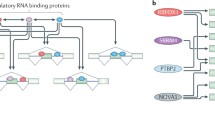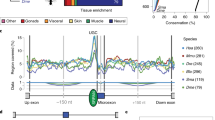Abstract
ZNF265 is a newly identified arginine/serine-rich (SR) protein and has two transcript isoforms (ZNF265-1 and ZNF265-2) that autoregulate between each other. Previous studies have shown that ZNF265 regulates the Tra2β isoform splicing. Here, we demonstrate that two ZNF-265 transcript isoforms are expressed in various mouse tissues and that ZNF265-1 is a major isoform. The ZNF265-1 protein level in the cerebral cortex is significantly lower in relative to other tissues. The recombinant proteins of both isoforms are nuclear, in consistent with its functions as pre-mRNA splicing regulators. Splicing analysis with GluR-B and SMN2 minigenes demonstrates that ZNF265-1 inhibits the Flop exon and exon 7 usages in the splicing of two minigenes, respectively. The regulation of GluR-B and SMN2 pre-mRNA splicing by ZNF265 implies this newly identified SR protein may play important roles in maintaining normal neuronal function and SMA pathogenesis.





Similar content being viewed by others
References
Karginova EA, Pentz ES, Kazakova IG et al (1997) Zis: a developmentally regulated gene expressed in juxtaglomerular cells. Am J Physiol 42:F731–F738
Nakano M, Yoshiura K, Oikawa M et al (1998) Identification, characterization and mapping of the human ZIS (zinc-finger, splicing) gene. Gene 225:59–65
Adams DJ, Van der Weyden L, Kovacic A et al (2000) Chromosome localization and characterization of the mouse and human zinc finger protein 265 gene. Cytogenet Cell Genet 88:68–73
Plambeck CA, Kwan AHY, Adams DJ et al (2003) The structure of the zinc finger domain from human splicing factor ZNF265 fold. J Biol Chem 278:22805–22811
Adams DJ, Van der Weyden L, Mayeda A et al (2001) ZNF265—a novel spliceosomal protein able to induce alternative splicing. J Cell Biol 154:25–32
Chen XH, Li J, Wu K et al (2005) Tra2α promotes RA induced neural differentiation of P19 cells. Neurochem Res 30:271–275
Lorson CL, Hahnen E, Androphy EJ et al (1999) A single nucleotide in the SMN gene regulates splicing and is responsible for spinal muscular atrophy. Proc Natl Acad Sci USA 96:6307–6311
Chen XH, Huang J, Li J et al (2004) Tra2β1 regulates P19 neuronal differentiation and the splicing of FGF-2R and GluR-B minigenes. Cell Biol Int 28:791–799
Stoss O, Stoilov P, Hartmann AM et al (1999) The in vivo minigene approach to analyze tissue-specific splicing. Brain Res Brain Res Protoc 4:383–394
Li J, Chen XH, Lin WM et al (2004) Establishment and application of minigene models for studying pre-mRNA alternative splicing. Sci China Ser C 47:211–218
Koike M, Tsukada S, Tsuzuki K et al (2000) Regulation of kinetic properties of GluR2 AMPA receptor channels by alternative splicing. J Neurosci 20:2166–2174
Cartegni L, Hastings ML, Calarco JA et al (2006) Determinants of exon 7 splicing in the spinal muscular atrophy genes, SMN1 and SMN2. Am J Hum Genet 78:63–77
Lefebvre S, Burlet P, Liu Q et al (1997) Correlation between severity and SMN protein level in spinal muscular atrophy. Nature Genet 16:265–269
Lorson CL, Androphy EJ (2000) An exonic enhancer is required for inclusion of an essential exon in the SMA-determining gene SMN. Hum Mol Genet 9:259–265
Lorson CL, Strasswimmer J, Yao JM et al (1998) SMN oligomerization defect correlates with spinal muscular atrophy severity. Nat Genet 19:63–66
Liu Q, Fischer U, Wang F et al (1997) The spinal muscular atrophy disease gene product, SMN, and its associated protein SIP1 are in a complex with spliceosomal snRNP proteins. Cell 90:1013–1021
Stoilov P, Daoud R, Nayler O, Stamm S (2004) Human tra2-beta1 autoregulates its protein concentration by influencing alternative splicing of its pre-mRNA. Hum Mol Genet 13:509–524
Garcia-Blanco MA, Baraniak AP, Lasda EL (2004) Alternative splicing in disease and therapy. Nat Biotechnol 22:535–546
Bochet P, Audinat E, Lambolez B et al (1994) Subunit composition at the single-cell level explains functional properties of a glutamate-gated channel. Neuron 12:383–388
Jonas P, Racca C, Sakmann B et al (1994) Differences in Ca2+ permeability of AMPA-type glutamate receptor channels in neocortical neurons caused by differential GluR-B subunit expression. Neuron 12:1281–1289
Lambolez B, Ropert N, Perrais D et al (1996) Correlation between kinetics and RNA splicing of α-amino-3-hydroxy-5-methylisoxazole-4-propionicacid receptors in neocortical neurons. Proc Natl Acad Sci USA 93:1797–1802
Singh NN, Androphy EJ, Singh RN (2004) The regulation and regulatory activities of alternative splicing of the SMN gene. Crit Rev Eukar Gene Expr 14:271–285
Acknowledgments
We thank Dr. Brunhilde Wirth (Bonn University, Germany) for the gift of the plasmids of SMN2 minigene. This work was supported by National Foundation of Natural Sciences of China (#30470383, #30470535).
Author information
Authors and Affiliations
Corresponding authors
Rights and permissions
About this article
Cite this article
Li, J., Chen, Xh., Xiao, Pj. et al. Expression Pattern and Splicing Function of Mouse ZNF265. Neurochem Res 33, 483–489 (2008). https://doi.org/10.1007/s11064-007-9461-3
Received:
Accepted:
Published:
Issue Date:
DOI: https://doi.org/10.1007/s11064-007-9461-3




